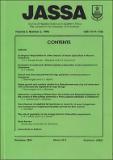| dc.contributor.author | Bowyer-Bower, T.A.S. | |
| dc.contributor.author | Mapaure, I. | |
| dc.contributor.author | Drummond, R.B. | |
| dc.coverage.spatial | Zimbabwe. | en |
| dc.date.accessioned | 2016-02-08T12:55:10Z | |
| dc.date.available | 2016-02-08T12:55:10Z | |
| dc.date.issued | 1996 | |
| dc.identifier.citation | Bowyer-Bower, T.A.S., Mapaure, I. and Drummond, R.B. (1996) Ecological degradation in cities: impact of urban agriculture In Harare, Zimbabwe, Journal of Applied Science in Southern Africa (JASSA) vol. 2, no.2, pp. 53-69. Harare: UZ. | en |
| dc.identifier.issn | 1019-7788 | |
| dc.identifier.uri | https://opendocs.ids.ac.uk/opendocs/handle/20.500.12413/8920 | |
| dc.description | A journal article on the impact on the environment of urban agriculture in Zimbabwe. | en |
| dc.description.abstract | The effect of the increasingly widespread practice of urban agriculture in the City of Harare on the natural biodiversity was investigated. Vegetation surveys noting species presence-absence and abundance were undertaken in seven field areas, identifying the components of the natural vegetation of both the clay soil-type areas developed on basic rock, and the sandy soil-type areas developed on granite, that typify the city. Change brought about by the increasingly widespread practice of urban agriculture was determined, and knock-on effects for other aspects of the city's ecology were investigated. Most open space areas in Harare are vlei land. Detrended Correspondence Analysis (DCA) illustrated significant differences in the species composition of uncultivated vlei areas with distance from the vlei channel, reflecting change in the water-logging conditions of the soil. A higher diversity of faunal species, and larger species count, prior to cultivation was also noted. The effects of cultivation on the vegetation were a change in species composition (with the natural vegetation being replaced by mainly alien arable weeds), the loss of the spatial diversity in species presence and dominance, a significantly reduced ground cover, and a loss of habitat diversity. The implications of these changes for the amenity value of the city environment is discussed. The need for a more sensitive management of open-land areas within Harare, while the possibility of their conservation as areas of viable natural ecological diversity is still available, is highlighted. | en |
| dc.language.iso | en | en |
| dc.publisher | University of Zimbabwe (UZ) Publications. | en |
| dc.rights.uri | http://creativecommons.org/licenses/by-nc-nd/3.0/ | en |
| dc.subject | Agriculture | en |
| dc.subject | Environment | en |
| dc.title | Ecological degradation in cities: impact of urban agriculture In Harare, Zimbabwe | en |
| dc.type | Article | en |
| dc.rights.holder | University of Zimbabwe (UZ) | en |


